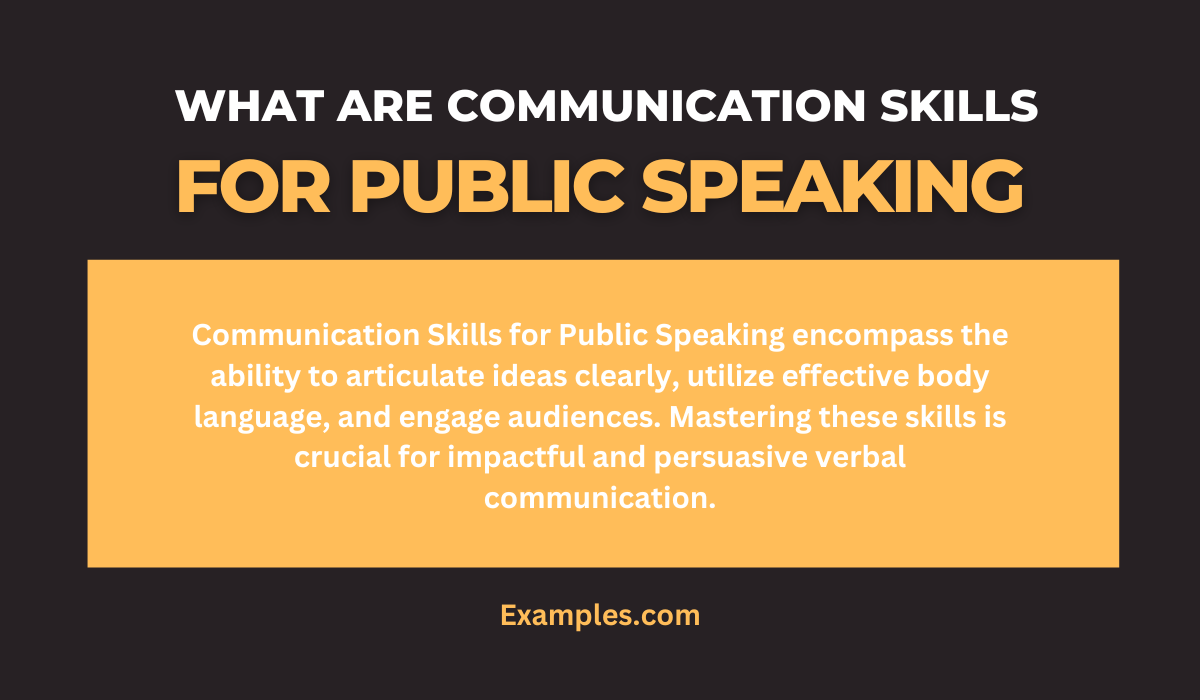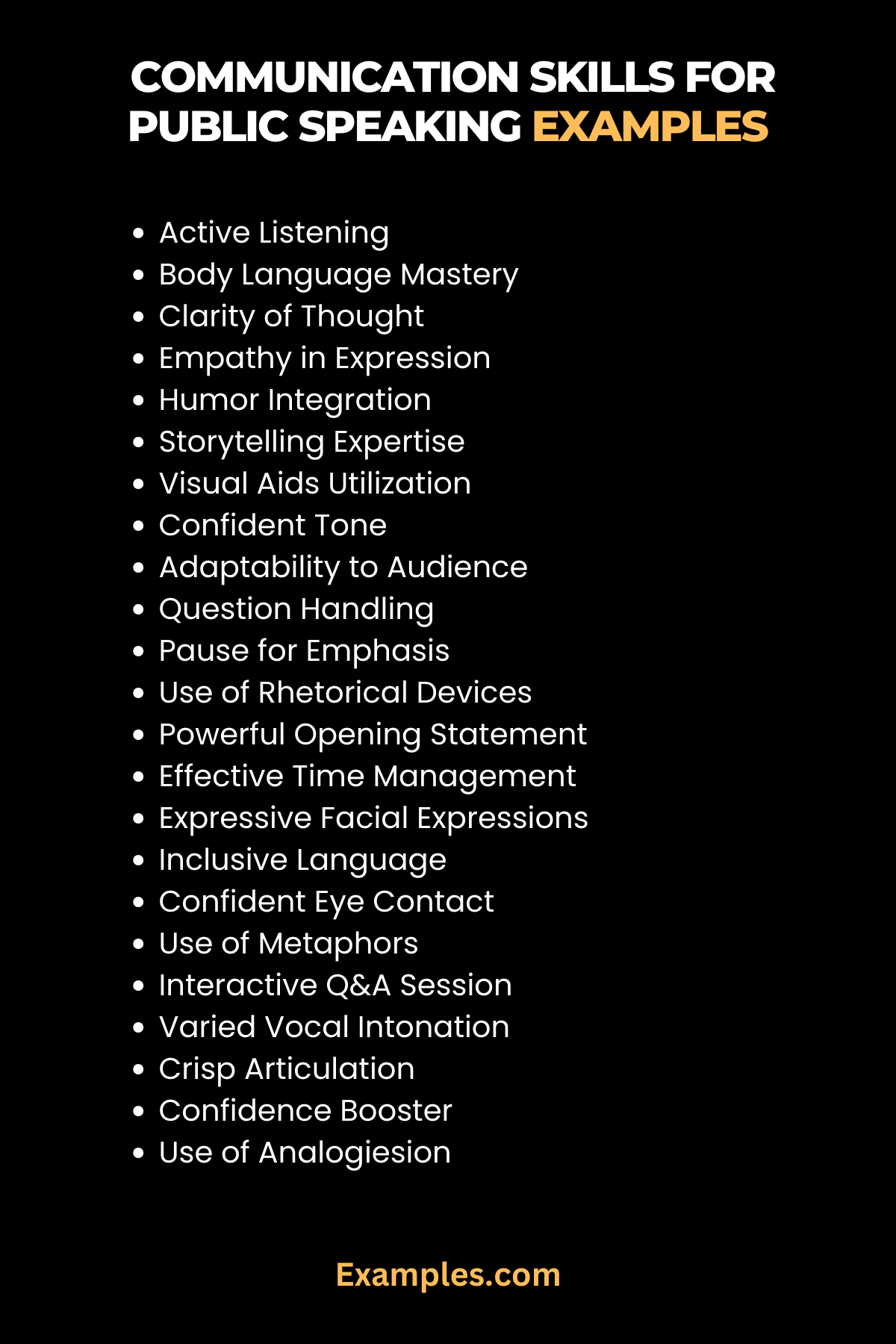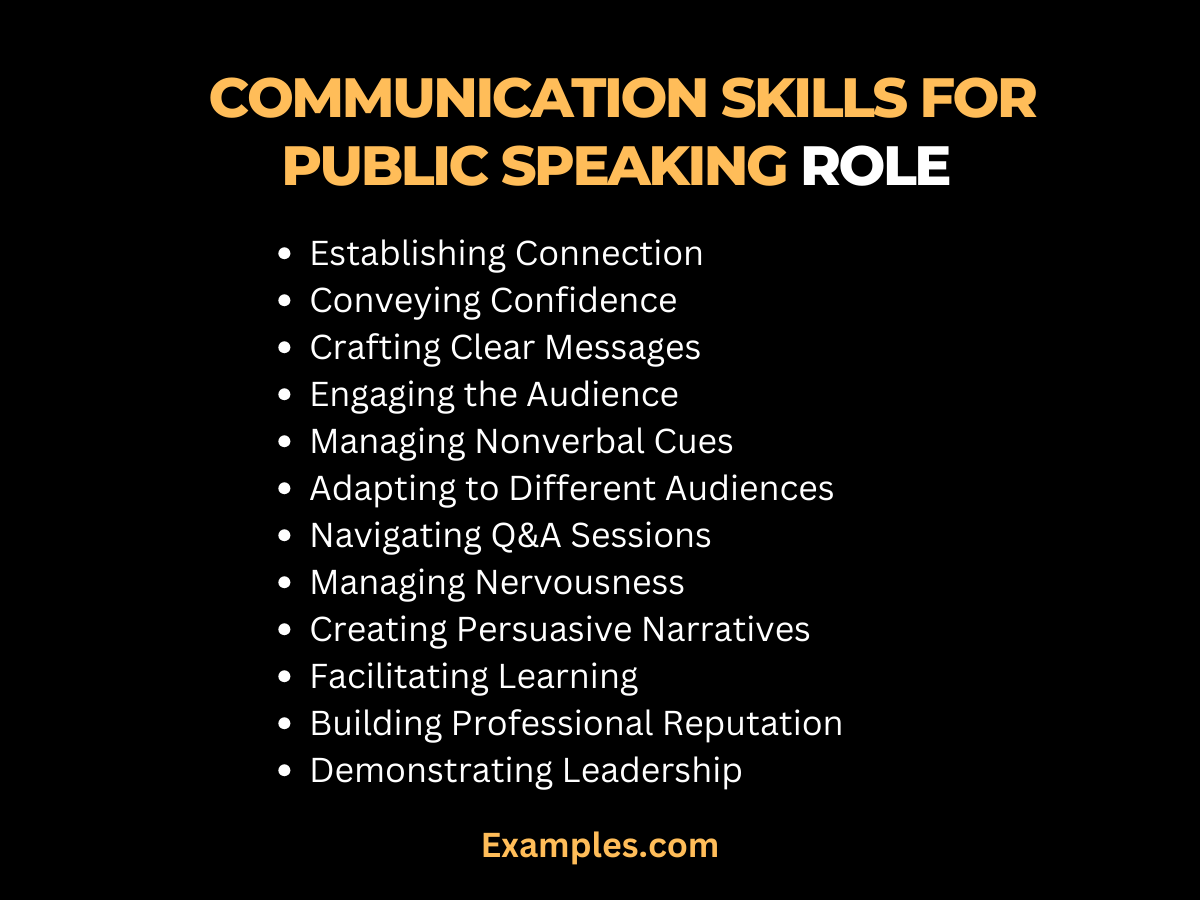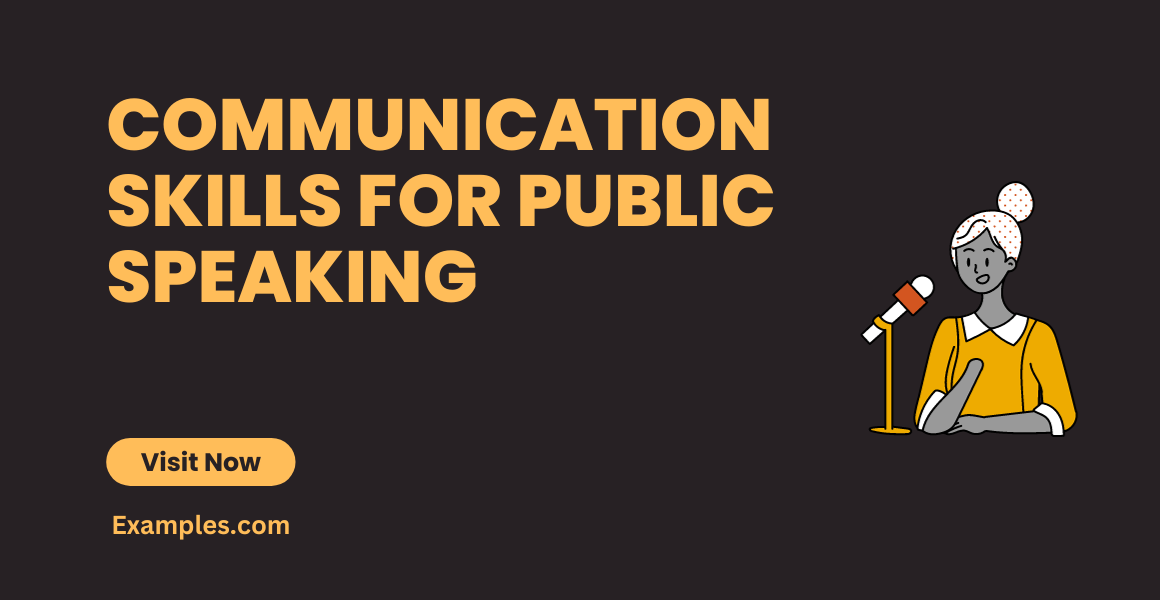29+ Communication Skills for Public Speaking Examples
Embarking on a journey to master public speaking demands honing essential communication skills. In this comprehensive guide, we delve into the intricacies, unveiling practical insights and vivid communication examples to empower your oratory prowess. Unveil the secrets of compelling oratory, as we navigate through real-world scenarios and expert insights. From decoding nonverbal cues to mastering verbal eloquence, this guide is your key to becoming a persuasive communicator. Elevate your skills with vivid “Communication Examples,” ensuring you command attention and leave a lasting impact in every public speaking endeavor. Explore, learn, and refine your communication finesse today.
What are Communication Skills For Public Speaking?
In the realm of public speaking, possessing adept communication skills is pivotal. These skills encompass verbal eloquence, persuasive techniques, and a nuanced grasp of nonverbal cues. In essence, it’s the art of conveying messages effectively and engagingly to diverse audiences. In simple terms, it involves articulating ideas clearly, using compelling language, and understanding nonverbal cues. Proficient public speakers seamlessly blend verbal and nonverbal elements, captivating audiences through eloquence and engagement. These skills empower individuals to convey messages persuasively, fostering a profound connection with diverse listeners. Mastering these skills enhances one’s ability to communicate with impact and resonance.

30 Communication Skills For Public Speaking Examples
Unleash the power of effective communication with our curated list of 30 exemplary public speaking skills. From mastering nonverbal cues to articulating ideas with precision, this collection is your guide to impactful oratory. Elevate your speaking finesse with these diverse skills, ensuring you command attention and leave a lasting impression.

- Active Listening: Acknowledging the audience’s input fosters engagement, as demonstrated when the speaker keenly responded to questions, creating a dynamic and inclusive atmosphere.
- Body Language Mastery: A confident posture and gestures underscored the speaker’s points, amplifying the impact of their message and establishing a powerful connection with the audience.
- Clarity of Thought: The speaker’s organized thoughts and clear articulation enabled the audience to grasp complex concepts easily, ensuring a seamless flow of information.
- Empathy in Expression: By sharing relatable anecdotes, the speaker showcased empathy, creating a genuine connection with the audience and enhancing the emotional resonance of the message.
- Humor Integration: Skillful use of humor lightened the atmosphere, making the content more memorable and fostering a positive rapport between the speaker and the audience.
- Storytelling Expertise: The speaker wove a compelling narrative, making abstract concepts relatable and engaging, thereby capturing the audience’s attention and leaving a lasting impression.
- Visual Aids Utilization: Incorporating relevant visuals enhanced understanding, as the speaker used graphs and images to complement verbal explanations, making the presentation more comprehensive.
- Confident Tone: A confident and authoritative tone conveyed assurance, instilling trust in the audience and establishing the speaker as a credible source of information.
- Adaptability to Audience: The speaker adjusted their communication style based on the audience’s demographics, ensuring inclusivity and resonating with diverse listeners.
- Question Handling: Addressing queries adeptly demonstrated the speaker’s expertise, fostering a dynamic exchange with the audience and reinforcing the credibility of the presentation.
- Pause for Emphasis: Strategic pauses between key points allowed the audience to absorb information, emphasizing crucial details and enhancing overall comprehension.
- Use of Rhetorical Devices: Employing rhetorical questions and impactful language heightened the rhetorical appeal, creating a persuasive and memorable speech.
- Powerful Opening Statement: A captivating opening statement immediately grabbed the audience’s attention, setting the tone for an engaging and impactful presentation.
- Effective Time Management: The speaker maintained a well-paced delivery, ensuring that each segment received adequate attention and preventing information overload for the audience.
- Expressive Facial Expressions: Varied facial expressions complemented verbal communication, adding nuance to the speaker’s emotions and reinforcing the authenticity of the message.
- Inclusive Language: The use of inclusive language made the audience feel seen and valued, fostering a sense of connection and promoting engagement throughout the presentation.
- Confident Eye Contact: Maintaining eye contact conveyed sincerity and confidence, establishing a direct connection with the audience and enhancing the speaker’s credibility.
- Use of Metaphors: Introducing metaphors creatively illustrated complex ideas, making the content more accessible and facilitating a deeper understanding among the audience.
- Interactive Q&A Session: Encouraging audience participation through questions and answers created a dynamic exchange, enhancing engagement and tailoring the presentation to specific interests.
- Varied Vocal Intonation: A dynamic range of vocal intonation added emphasis and emotion to the speaker’s words, preventing monotony and sustaining the audience’s interest.
- Crisp Articulation: Clear and crisp articulation ensured that every word was easily comprehensible, enhancing the overall clarity and impact of the presentation.
- Confidence Booster: The speaker seamlessly navigated unexpected interruptions, showcasing resilience and maintaining confidence, ensuring an uninterrupted and composed delivery.
- Use of Analogies: Drawing parallels with familiar situations through analogies facilitated a deeper understanding, making complex concepts more relatable for the audience.
- Engaging Opening Hook: A captivating opening hook immediately grabbed the audience’s attention, setting the stage for a compelling and memorable presentation.
- Adaptive Language Style: Tailoring language complexity to the audience’s comprehension level ensured universal understanding, accommodating diverse levels of familiarity with the subject matter.
- Authenticity in Expression: The speaker’s genuine passion for the topic resonated authentically, creating a connection with the audience and fostering a more profound impact.
- Effective Use of Pauses: Well-timed pauses between key ideas allowed the audience to digest information, emphasizing critical points and enhancing overall retention.
- Confident Hand Gestures: Purposeful hand gestures complemented verbal communication, adding a visual dimension to the speaker’s message and reinforcing key points.
- Audience Interaction: Directly engaging with the audience through questions and comments created a participatory atmosphere, enhancing the overall impact of the presentation.
- Call to Action Closure: Concluding with a compelling call to action inspired the audience to take tangible steps, ensuring the speech culminated with a lasting impact and a sense of purpose.
Communication Skills For Public Speaking Examples for Students
Unlock the potential of effective communication with tailored examples for students. From class presentations to group discussions, these instances illuminate the diverse facets of public speaking skills, equipping students with the tools to express themselves confidently and persuasively.
- Interactive Classroom Discussions: Engage actively with peers, fostering an environment where diverse opinions are valued, contributing to a richer exchange of ideas.
- Effective Use of Visual Aids in Presentations: Utilize slides and props to enhance understanding, ensuring classmates grasp complex concepts through a combination of visual and verbal communication.
- Adapting Tone for Varied Audiences: Learn to modulate tone and language based on the audience’s familiarity with the subject, ensuring clear and relatable communication for different groups.
- Handling Nervousness with Grace: Navigate pre-presentation jitters by incorporating controlled breathing and positive self-talk, allowing students to communicate confidently despite initial anxiety.
- Peer Feedback Sessions: Participate actively in providing constructive feedback to classmates, honing both the ability to critique and accept feedback for continuous improvement.
- Team Project Pitches: Master the art of collaborative presentations, where effective coordination and clear communication contribute to the success of team projects.
- Incorporating Personal Narratives: Infuse presentations with personal anecdotes, creating a connection with the audience and making the content more memorable.
- Role-Playing Scenarios: Engage in simulated scenarios, practicing spontaneous communication and quick thinking, crucial skills for impromptu speaking situations.
- Public Speaking Workshops: Attend workshops focusing on public speaking skills, where students can refine their techniques under the guidance of experienced communicators.
- Showcasing Research Findings: Develop the ability to articulate complex research findings in a coherent and accessible manner, enhancing both clarity and persuasiveness in academic presentations.
Communication Skills For Public Speaking Examples in Movies
Discover how the silver screen becomes a canvas for powerful communication. In movies, characters showcase a spectrum of public speaking skills, from compelling speeches to subtle nonverbal cues, offering valuable insights into the art of cinematic communication.
- Inspirational Speeches: Witness characters delivering motivational speeches that resonate, employing rhetoric and passion to captivate audiences, as seen in films like “Dead Poets Society.”
- Effective Persuasion in Courtroom Dramas: Explore the skillful use of persuasive language, cross-examination techniques, and the ability to sway opinions, exemplified in movies like “To Kill a Mockingbird.”
- Nonverbal Communication Mastery: Observe characters who convey volumes without words, using facial expressions, gestures, and body language, as portrayed in silent films like “The Artist.”
- Intercultural Communication in Global Settings: Experience characters navigating communication challenges in diverse settings, exemplified by the multicultural interactions in movies like “Lost in Translation.”
- Convincing Negotiation Scenes: Analyze characters negotiating effectively, employing tactics and verbal finesse to reach agreements, a skill showcased in films like “The Social Network.”
- Expressive Monologues: Delve into emotionally charged monologues that showcase the power of words and delivery, as demonstrated in iconic films like “A Few Good Men.”
- Dynamic Panel Discussions: Witness characters engaging in dynamic group discussions, showcasing the ability to navigate diverse perspectives, such as in the movie “12 Angry Men.”
- Crisis Communication in Action: Explore characters adeptly managing crises through clear communication, exemplified by leaders in films like “Apollo 13.”
- Storytelling Techniques: Observe characters weaving compelling narratives, using storytelling to engage and captivate audiences, a skill showcased in movies like “Forrest Gump.”
- Effective Communication in Conflict Resolution: Analyze characters resolving conflicts through effective communication, as seen in films like “The King’s Speech,” where speech therapy aids in overcoming a communication barrier.
Communication Skills For Public Speaking Examples at Business
Elevate your business discourse with these Communication Skills for Public Speaking examples. From impactful presentations to effective negotiation, master the art of conveying ideas in a corporate setting. Seamlessly navigate through diverse scenarios, ensuring your communication resonates with professionalism and influence.
- Executive Presence: In board meetings, exude confidence through composed body language, articulate speech, and concise messaging, establishing a commanding executive presence.
- Negotiation Mastery: Craft persuasive arguments, actively listen to counterpoints, and use nonverbal cues to foster a positive negotiation environment, ensuring successful business discussions.
- Client Pitch Excellence: Deliver compelling client pitches by blending data-driven insights with relatable narratives, creating an engaging presentation that resonates with potential clients.
- Team Collaboration: Facilitate effective team communication through inclusive language, fostering an environment where diverse perspectives are valued, leading to enhanced collaboration.
- Cross-Functional Communication: Bridge communication gaps between departments by simplifying complex concepts, ensuring seamless cross-functional understanding and alignment towards common goals.
- Boardroom Diplomacy: Navigate delicate discussions with tact and diplomacy, using precise language and strategic pauses to address sensitive issues, maintaining a harmonious boardroom atmosphere.
- Stakeholder Engagement: Engage stakeholders effectively through tailored communication, addressing concerns with empathy and clarity, ensuring a cohesive approach towards shared objectives.
- Crisis Management Address: During crises, convey a sense of control and assurance through clear communication, keeping stakeholders informed and maintaining trust amidst challenging situations.
- Leadership Communication: Exemplify leadership through inspirational communication, using motivational language and a visionary tone to instill confidence and inspire teams.
- Sales Presentation Impact: Optimize sales presentations with dynamic storytelling, addressing client pain points, and using persuasive language to create a compelling case for your products or services.
Communication Skills For Public Speaking Examples at Work
Refine your workplace communication with these Public Speaking examples tailored for professional settings. From team meetings to project updates, these skills ensure your messages are delivered with precision and impact, fostering a communicative workplace culture.
- Effective Team Briefings: Conduct team briefings with clarity and enthusiasm, ensuring everyone understands their roles and fostering a collaborative and motivated team environment.
- Performance Review Delivery: Communicate constructive feedback during performance reviews with empathy and specific examples, guiding employees towards improvement and growth.
- Project Status Updates: Deliver project updates with a focus on key milestones, using visual aids and concise language to keep team members informed and engaged.
- Conflict Resolution Dialogue: Navigate workplace conflicts by actively listening to concerns, expressing understanding, and using assertive communication to find common ground and resolution.
- Remote Team Connection: Foster a sense of connection in remote teams through clear and regular communication, utilizing virtual platforms effectively to maintain team cohesion.
- Meeting Facilitation: Lead meetings with precision, ensuring active participation, and summarizing key points, facilitating efficient and productive discussions.
- Email Communication: Craft emails with clarity and brevity, ensuring messages are easily understood and promoting effective communication in written form.
- Feedback Elicitation: Encourage open and constructive feedback from team members, creating a culture of continuous improvement and mutual respect in the workplace.
- Professional Networking: Navigate networking events with ease, using engaging conversation starters and concise self-introductions to make lasting professional connections.
- Adaptability Expression: Effectively communicate changes in the workplace by emphasizing the positive aspects, addressing concerns, and maintaining transparency, ensuring smooth transitions for all employees.
What is the Role of Communication Skills for Public Speaking?
Public speaking is a dynamic art that hinges on effective communication skills. These skills play a pivotal role in shaping the success of a speaker and the impact of their message. Here’s a comprehensive guide outlining the multifaceted role of communication skills in public speaking:

- Establishing Connection: Communication skills forge a strong connection between the speaker and the audience. A speaker’s ability to resonate emotionally and intellectually hinges on their capacity to communicate ideas with clarity and conviction.
- Conveying Confidence: Confidence is a cornerstone of successful public speaking. Strong communication skills empower speakers to express themselves confidently, instilling trust and credibility in their message.
- Crafting Clear Messages: Public speaking involves conveying complex ideas in a clear and accessible manner. Effective communication skills enable speakers to articulate thoughts with precision, ensuring the audience comprehends the intended message.
- Engaging the Audience: An engaged audience is more likely to absorb and retain information. Communication skills, such as the use of storytelling, humor, and interactive elements, captivate listeners and foster a participatory atmosphere.
- Managing Nonverbal Cues: Beyond words, nonverbal cues significantly impact audience perception. Communication skills encompass the mastery of body language, facial expressions, and gestures, amplifying the speaker’s message and reinforcing authenticity.
- Adapting to Different Audiences: Public speaking often involves addressing diverse audiences. Effective communicators possess the skill to adapt their language, tone, and content to resonate with the specific demographics and interests of their listeners.
- Navigating Q&A Sessions: The ability to handle questions and answers with finesse is a testament to strong communication skills. Speakers must articulate responses clearly, confidently, and diplomatically, ensuring a seamless flow of dialogue.
- Managing Nervousness: Public speaking can be nerve-wracking, even for seasoned speakers. Communication skills equip individuals with techniques to manage nervousness, ensuring a poised and composed delivery.
- Creating Persuasive Narratives: Persuasion is a key objective in many public speaking scenarios. Communication skills enable speakers to craft compelling narratives, leveraging rhetorical devices and persuasive language to sway opinions and inspire action.
- Facilitating Learning: Public speaking is not only about conveying information but also about facilitating learning. Effective communication skills aid in creating an educational experience, ensuring that the audience gains valuable insights and knowledge.
- Building Professional Reputation: A speaker’s professional reputation is closely tied to their communication skills. Whether in business, academia, or public forums, strong communication enhances a speaker’s credibility, contributing to long-term success.
- Demonstrating Leadership: Public speaking often occurs in leadership contexts. Communication skills are vital for leaders to inspire, motivate, and guide their teams, fostering a culture of trust and collaboration.
- Navigating Multimodal Communication: In the digital age, public speaking extends beyond physical platforms. Communication skills encompass proficiency in various communication channels, including virtual presentations, webinars, and social media engagements.
- Ensuring Message Retention: An impactful message is one that lingers in the minds of the audience. Communication skills, including repetition, emphasis, and strategic pauses, contribute to enhanced message retention among listeners.
- Encouraging Action: The ultimate goal of public speaking is often to prompt action. Effective communication skills empower speakers to issue clear calls to action, motivating the audience to implement the ideas presented.
In What Way Does Public Speaking Improve Communication Skills?
Public speaking serves as a powerful crucible for honing and refining communication skills in various dimensions. The process of preparing, delivering, and responding to an audience provides a unique opportunity for continuous improvement and growth in communication proficiency. Public speaking also cultivates confidence, a vital component of effective communication. As individuals repeatedly engage in public speaking, they overcome stage fright, build self-assurance, and project a more assertive and compelling presence. Confidence in communication is contagious, capturing the audience’s attention and reinforcing the speaker’s credibility.
Public speaking facilitating growth in several key areas.
- Verbal Artistry: Public speaking demands precision in language use, expanding vocabulary, and refining articulation to convey ideas with clarity and impact.
- Nonverbal Dexterity: Speakers develop a heightened awareness of body language, gestures, and facial expressions, mastering the art of nonverbal communication for enhanced expressiveness.
- Active Listening: To engage an audience effectively, speakers must adeptly listen and respond, fostering a reciprocal communication dynamic that transcends mere monologues.
- Empathy Cultivation: Understanding diverse audience perspectives fosters empathy, enabling speakers to tailor messages that resonate deeply with varied individuals.
- Confidence Building: Regular public speaking builds confidence, enabling speakers to navigate diverse settings with assurance and poise.
- Adaptability: Public speakers learn to adapt their communication style to suit different audiences, refining their ability to convey messages effectively in varied contexts.
- Crisis Communication: The pressure of public speaking prepares individuals to communicate effectively during high-stakes situations, cultivating crisis management skills.
- Narrative Mastery: Crafting compelling stories develops the ability to weave narratives that capture attention, making complex information more accessible and memorable.
- Feedback Integration: Public speakers learn to incorporate feedback constructively, fostering a continuous improvement mindset and refining their communication strategies.
- Influence and Persuasion: Through public speaking, individuals refine their persuasive techniques, mastering the art of influencing opinions and inspiring action through effective communication.
What are the Advantages of Public Speaking Communication?
Public speaking communication holds a multitude of advantages, transcending individual growth and professional success. Understanding these benefits illuminates the significance of honing effective communication skills for public speaking:
- Enhanced Confidence:
- Public speaking fosters self-assurance by challenging individuals to express ideas assertively and face an audience confidently.
- Improved Articulation:
- Regular public speaking sharpens articulation skills, refining the ability to convey thoughts clearly and persuasively.
- Career Advancement:
- Proficient communicators often ascend professionally, as effective public speaking is a prized skill in leadership roles.
- Influence and Persuasion:
- Public speakers wield influence, swaying opinions and persuading audiences through the power of compelling communication.
- Networking Opportunities:
- Public speaking engagements provide platforms for networking, connecting individuals with like-minded professionals and potential collaborators.
- Knowledge Retention:
- The act of preparing and delivering speeches enhances information retention, reinforcing the speaker’s grasp on the subject matter.
- Leadership Development:
- Public speaking nurtures leadership qualities, as it demands the ability to guide, inspire, and convey a compelling vision to others.
- Effective Storytelling:
- Public speakers master the art of storytelling, making their messages memorable and creating a lasting impact on their audience.
- Crisis Communication Skills:
- Proficient public speakers can navigate challenging situations with grace, addressing crises effectively and maintaining composure.
- Global Communication Competence:
- Public speaking transcends borders, enabling individuals to communicate effectively in diverse cultural and global contexts.
Tips for Effective Communication Skills For Public Speaking
Mastering communication skills for public speaking is a transformative journey. Employ these tips to elevate your oratory finesse and leave a lasting impression on your audience:
- Know Your Audience:
- Tailor your message to resonate with the demographics, interests, and knowledge level of your audience.
- Practice Regularly:
- Practice breeds proficiency. Rehearse your speeches to enhance fluency, clarity, and confidence in delivering your message.
- Utilize Visual Aids Wisely:
- Enhance your message with visual aids, but ensure they complement, not overshadow, your verbal communication.
- Control Nervousness:
- Embrace nervous energy as a source of vitality. Channel it positively through deep breaths and focused mindfulness.
- Effective Use of Body Language:
- Leverage confident body language to underscore key points and establish a strong connection with your audience.
- Engage Your Audience:
- Foster audience engagement through interactive elements, questions, or anecdotes, creating a participatory atmosphere.
- Structure Your Speech:
- Organize your speech with a clear introduction, body, and conclusion, ensuring a logical and compelling flow of information.
- Craft Compelling Openings and Closings:
- Capture attention with a captivating opening and leave a lasting impression with a powerful closing statement.
- Adapt to Unexpected Changes:
- Be flexible and adaptable, ready to navigate unexpected changes or interruptions with grace and composure.
- Seek Constructive Feedback:
- Solicit feedback from peers or mentors to gain valuable insights, refining your communication skills through continuous improvement.
In conclusion, mastering Communication Skills for Public Speaking is a transformative journey toward impactful expression. This complete guide, enriched with vivid examples, equips you with the tools to navigate diverse scenarios. From effective body language to persuasive storytelling, elevate your oratory finesse. Embrace these skills to confidently engage audiences, leaving an enduring impact in both professional and personal spheres.



